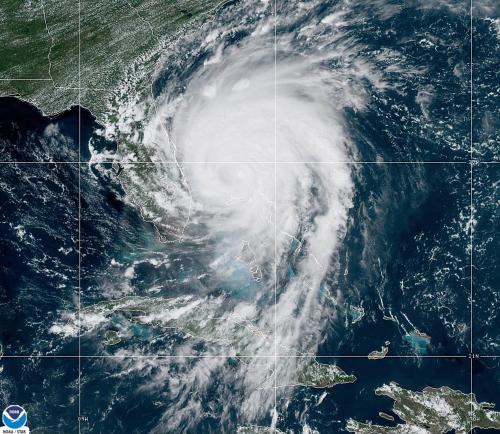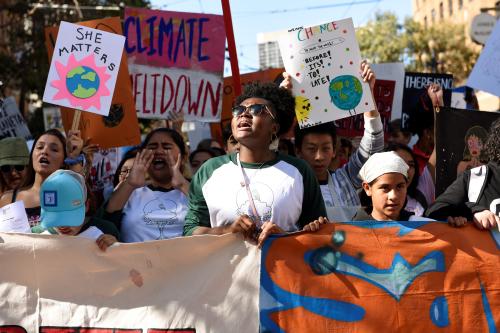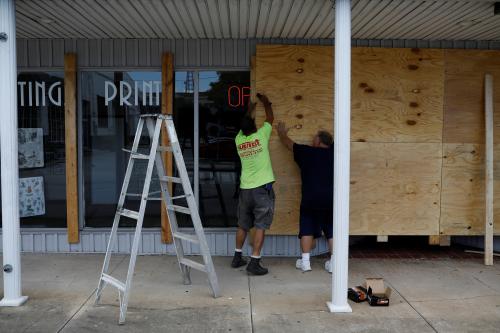Hurricane Sandy struck just before Election Day. The political machine couldn’t help itself. Governor Christie “has gone soft” on President Obama. Candidate Mitt Romney wants disaster assistance to be taken “from the federal government and [sent] back to the states,” his opponents cry. And the right charges President Obama and the Democrats with using Sandy “to justify a bigger federal government.”
We have hit another political low. As hundreds of families remain displaced from their homes or stranded without power, disaster recovery falls prey to the tired question of who can govern it best. The reality is that rebuilding New York, coastal New Jersey, and all the communities along the unfortunate path of Hurricane Sandy will require the close coordination of federal, state, and local governments, and private sector partners, no matter the political stripes of the leaders involved.
The question is: Has our nation’s response to major disasters improved since Hurricane Katrina, the last time a storm left such a catastrophic mark on the United States?
Hurricane Katrina forced our leaders to confront what was structurally broken about government’s response to large-scale disasters. Simply, the nation didn’t have an adequate system for dealing with them. The Stafford Act provides the core foundation for national emergency disaster relief but is generally ill-equipped to support major catastrophes, including their colossal recovery needs. Yet hurricanes Katrina and Sandy provide a stark reminder that large-scale disasters are happening more frequently. Further, such massive disasters require not just emergency aid to families and the restoration of basic public services. They also trigger the simultaneous need for short- and longer-term resources to rebuild bridges, tunnels, homes, hospitals, neighborhoods, and other key facets of community and economic life. This is complex and costly work, requiring coordination across many actors and across a vast geography of destruction.
After six years learning from the hardworking people of New Orleans and southern Louisiana post-Katrina, and others who dedicate their lives to disaster recovery, let me offer just a few basic tenets of a productive post-disaster response system.
The first is that the federal government matters. This may make small government advocates cringe, but the truth is that Washington is essential to the immediate aftermath of a major disaster. The federal government is the only level of government capable of providing timely and predictable resources and capacity, irrespective of where disaster strikes, when state and local resources are often thin and uneven. The federal government also has the ability to address disasters at scale since most catastrophic impacts span multiple states and municipalities (Sandy impacted 10 states and the District of Columbia). They must set the rules for disaster assistance and make every attempt to provide flexible tools for states and localities. This is because…
All post-disaster recovery is local. Disasters strike large urban centers and small towns. Thus it is ultimately incumbent upon states and localities to prioritize how best to deploy government, private sector, and philanthropic resources in the rebuilding of their communities in ways that reflect local will and vision. State leaders also aim to provide local leaders with a wide range of tools and resources in recovery and to serve as coordinator and broker between jurisdictions, especially in states with many small towns and cities such as New Jersey.
The high number of categorical federal programs for post-disaster recovery demands maximum flexibility to empower state and local decisionmaking. By one count, there are more than 50 post-disaster recovery-related federal programs. This creates enormous headaches for state and local leaders. First, post-disaster recovery is so complex and comprehensive that solutions don’t fit neatly into program pots or silos. Second, local leaders spend tremendous amount of time trying to figure out which program fits their recovery needs and tailoring their response to federal program rules when, in reality, the reverse should be true: federal programs should be bending to local circumstances. Third, there is a steep learning curve with these federal programs, hindering the speed and nimbleness of local and state responses.
So, have things improved since Katrina? Yes. In response to a mandate by the Post-Katrina Emergency Management Reform Act of 2006, FEMA released a new National Response Framework (NRF) to clarify the roles and responsibilities of key agencies and levels of government, and the resources available, for emergency response to all hazards. The Obama administration went further by releasing a parallel National Disaster Recovery Framework to create clear guidance to the recovery-side of the emergency response, a needed first. This framework makes enormous strides in empowering states and localities and making sure federal programs work better for a whole range of catastrophic circumstances.
So, the cautious good news for New York and New Jersey, now declared major disaster areas by the president, is that these states may be benefiting from concerted federal efforts to not repeat the mistakes from the 2005 hurricanes.
But this is just the beginning of a longer rebuilding effort. And next week’s election could change the nature of the federal response. No matter the outcome, our leaders need to set aside politics to ensure that government works together and efficiently for the people and businesses most impacted by Hurricane Sandy.



Commentary
Feds, States, Cities — The All of the Above Disaster Response
November 2, 2012